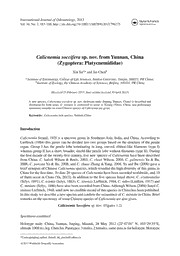
Calicnemia socciferasp. nov. from Yunnan, China (Zygoptera: Platycnemididae) PDF
Preview Calicnemia socciferasp. nov. from Yunnan, China (Zygoptera: Platycnemididae)
InternationalJournalofOdonatology,2013 Vol.16,No.2,183–188,http://dx.doi.org/10.1080/13887890.2013.796275 Calicnemia soccifera sp. nov. fromYunnan, China (Zygoptera: Platycnemididae) XinYua*andJinChenb aInstituteofEntomology,CollegeofLifeSciences,NankaiUniversity,Tianjin,300071,PRChina; bInstituteofZoology,theChineseAcademyofSciences,Beijing,100101,PRChina (Received25February2013;finalversionreceived10April2013) Anewspecies,Calicnemiasocciferasp.nov.(holotypemale:Jinping,Yunnan,China)isdescribedand illustratedforbothsexes.C.miniata isconfirmedtooccurinXizang(Tibet),China,andpreliminary taxonomicremarksonsomeChinesespeciesofCalicnemiaaregiven. Keywords: Calicnemia;newspecies;Yunnan;China Introduction CalicnemiaStrand,1928isaspeciosegenusinSoutheastAsia,India,andChina.Accordingto Lieftinck(1984)thisgenuscanbedividedintotwogroupsbasedonthestructureofthepenile organ. Group I has the penile lobe terminating in long, curved, ribbon-like filaments (type I) whereasgroupIIhasashort,broader,shield-likepenilelobewithoutfilaments(typeII).During thefirstdecadeofthetwenty-firstcentury,fivenewspeciesofCalicnemiahavebeendescribed from China: C. haksik Wilson & Reels, 2003; C. chaoi Wilson, 2004; C. gulinensisYu & Bu, 2008;C.porcataYu&Bu,2008;andC.zhuaeZhang&Yang,2008.YuandBu(2008)gavea briefsynopsisofChineseCalicnemiaspecies,whichrevealedthehighdiversityofthisgenusin Chinaforthefirsttime.Todate20speciesofCalicnemiahavebeenrecordedworldwide,and10 ofthemoccurinChina(Yu,2013).Inadditiontothefivespecieslistedabove,C.erythromelas (Selys,1891),C.eximia(Selys,1863),C.sinensisLieftinck,1984,C.miles(Laidlaw,1917)and C.miniata(Selys,1886)havealsobeenrecordedfromChina.AlthoughWilson(2004)listedC. imitansLieftinck,1948,untilnownocrediblerecordofthisspeciesinChinahasbeenpublished. InthisstudywedescribeanewspeciesandconfirmtheoccurrenceofC.miniatainChina.Brief remarksonthetaxonomyofsomeChinesespeciesofCalicnemiaarealsogiven. CalicnemiaSocciferasp.nov.(Figures1,2) Specimensexamined Holotype male. China, Yunnan, Jinping, Maandi, 28 May 2012 (22◦47(cid:3)01(cid:3)(cid:3) N, 103◦29(cid:3)35(cid:3)(cid:3)E, altitude1008m),leg.ChenJin.Paratypes:3males,2females,samedataasforholotype.Holotype *Correspondingauthor.Email:[email protected] ©2013WorldwideDragonflyAssociation 184 X.YuandJ.Chen Figure 1. Calicnemiasocciferasp.nov.(a)Maleface,holotype.(b–d)Variationinthecolorpatternofmaleheadand thoraxaccordingtothedegreeofmaturity:(b)fullymature,holotype;(c)mature;(d)semimature.(e–g)Caudalappendages ofmale,holotype:(e)dorsalview;(f)lateralview;(g)lateroventralview.(h)Paratypefemale,caudalappendages,lateral view.(i,j)Genitalligula,paratypemale:(i)ventralview;(j)lateralview. andparatypeswillbedepositedatInstituteofEntomology,CollegeofLifeSciencesofNankai University,Tianjin,China. Etymology TheLatinadjectivesoccifera[soccus+ferre]means“sock-wearing”andreferstotheremarkable blackcoloredtibiaeandtarsicomparedtothereddishbrownfemora. Calicnemiasocciferasp.nov.fromYunnan,China 185 Figure 2. Calicnemiasocciferasp.nov.,fieldphotos,paratypes:(a)maturemale;(b)semimaturemale;(c)female. Diagnosis Malewiththoraxblack,markedwithuniformyellowstripesthatbecomeobscuredbypruinosity inmatureindividuals,reddishfemoracontrastingwithblacktibiaeandtarsi,basalsegmentsof 186 X.YuandJ.Chen abdomenbrightredanddistalsegmentsblack.Femalewiththoraxsimilarbutmoreextensively yellow,notbecomingpruinose,abdomengenerallyyellowbrown,darkerdistally. Descriptionofholotypemale Head.Labiumpaleyellow.Labrum,basesofmandibles,genaereddishbrown.Anteclypeusred- dishbrownwithtwoblackspotsatdistalborder.Postclypeusblackcentrallyandreddishbrown laterally.Fronsandtopofheadmattblack,withapairofirregularreddishbrownspotsbetween lateral ocelli and base of antennae. Antennae wholly black. Postocular spots reddish brown, stripe-like,verysmall(Figure1a,b). Thorax.Prothoraxwhollyblackwithsidesfinelypruinose,twoindistinctreddishbrownspotsat upperlateralmargin.Synthoraxblackdorsally,withonlyindistinct,finelypruinosestripes.Sides ofsynthoraxalmostwhollyblack,exceptanindistinctpruinosenarrowyellowstripe,justabove second lateral suture, that covers spiracle (Figure 1b). Coxae, trochanters and femora reddish brown except one dark pruinose mark at outer faces of coxae, two dark spots at outer face of trochanters. Tibiae and tarsi blackish brown. Wings hyaline, pterostigma dark brown, braced, coveringonecell. Abdomen.Predominantlybrickred.Segment1yellowwithpaledarkbrowndorsalmarkand darkbrowndistalring.Segments2to5whollybrickredwithdarkbrowndistalrings.Segment 6 brick red on proximal 2/3 but black gradually to distal part. Segments 7–10 including cau- dalappendagesblack(Figure2a,b).CaudalappendagesasfiguredinFigure1e–gwithsuperior appendages1/4shorterthaninferiors,whicharetwiceaslongasabdominalsegment10.Cercifur- nishedwithtwolongsharpmiddleteeth.PenileorganasinFigure1i,jwithshort,shield-likelobe. Measurements(mm).HW23.0;abdomen+appendages31.0. Descriptionofaparatypefemale Head.Labiumandlabrumpaleyellow.Baseofmandiblesandgenaegreenishblue.Anteclypeus greenish blue with two black spots at distal border. Postclypeus black centrally and greenish blue laterally. Frons and top of head matt black, with a pair of irregular yellow spots between lateralocelliandbaseofantennae.Antennaewhollyblack.Postocularspotsyellow,verysmall, stripe-like. Thorax.Prothoraxblackdorsally,yellowlaterally.Synthoraxblackdorsally,withyellowante- humeralstripes.Sidesofsynthoraxblackabovemiddlelateralsutureandyellowbelow,excepta blackstripealongsecondlateralsuture,startingfromwingbaseandendingjustabovespiracle (cf. Figure 2c). Coxae and trochanters yellow except two small dark spots at distal margin of trochanters.Femora,tibiaeandtarsidarkbrown.Wingshyaline,pterostigmadarkbrown,braced, coveringonecell. Abdomen.Segment1yellowwithdarkbrowndorsalmarkanddarkbrowndistalring.Segments 2 to 5 brown dorsally and yellow ventrally, with dark brown distal rings. Segment 6 brown at dorsalproximal3/4,thendarkergraduallytodistalpart,yellowventrally.Segments7–10black dorsallyandyellowventrally.Caudalappendagesblack,aslongassegment10.Ovipositorrobust, extendingtotheendofabdomenasshowninFigure1h. Measurements(mm).HW22.0;abdomen+appendage28.0. Variationinmaleparatypes Measurements(mm).HW21.5–23.0;abdomen+appendages30.5–31.0.Thebodycolorpattern variesdependingofthedegreeofmaturity(cf.Figure1c,d).Youngerindividualsexhibitreduced Calicnemiasocciferasp.nov.fromYunnan,China 187 pruinosity. Labium, labrum, genae, anteclypeus, and spots on vertex mainly greenish brown. Postocular spots brown. Prothorax black dorsally and yellow laterally. Synthorax black above middlelateralsutureandyellowbelow,withyellowantehumeralstripesandablackstripealong secondlateralsuture.Coxaeandtrochantersyellow,femoraorange-yellow.Abdomencolorpaler inthematureindividuals. Variationinfemaleparatypes Measurements(mm).HW22.0–22.5;abdomen+appendages28.0–28.5.Bothavailablefemale specimenshavethesamecolorpattern,thoughtheyoungeronehasalittlepaleyellowcolor. Habitat Found in a montane stream at about 1000–1300m, no more than 50m away from a waterfall. Also occurring in the same area are Calicnemia eximia, the amphipterygid Devadatta ducatrix Lieftinck,1969andthemegapodagrionidAgriomorphafuscaMay,1933. Discussion Calicnemia soccifera resembles C. erythromelas in its body colors, but differs in the shape of the penile organ and caudal appendages. The penile lobe (Figure 1i) of C. soccifera is typical of type II species (Lieftinck, 1984) whereas that of C. erythromelas belongs to type I, since it isdividedintoapairofshorter,broadlyribbon-likeprocessesseparatedbyaV-shapedincision (cf. Lieftinck, 1977, p. 23, figure 15). Cerci of C. erythromelas bear very strongly developed middleteeth(cf.Lieftinck,1977,p.23,figures16–17;Yu&Bu,2008,p.249,figures1–3)that are longer than in C. soccifera (Figure 1f). In addition C. soccifera lacks a distinct broad pale stripe on the top of its head. The body color pattern of C. soccifera somewhat resembles also that of C. uenoiAsahina, 1997 fromVietnam, but in C. uenoi the shape of caudal appendages is very different, with only a short middle tooth on each cercus (cf. Asahina, 1997, p. 21, figure15). With the exception of C. erythromelas, C. eximia, and C. sinensis, the Chinese Calicnemia speciesbelongtotheGroupIIintheclassificationbyLieftinck(1984).Alltherecentlydescribed species (C. chaoi, C. haksik, C. gulinensis, C. porcata, C. zhuae and the present C. soccifera) belongtothisgroup,allofwhichhavebroaderandshield-likepenilelobeswithoutfilaments,as inC.miles(cf.Lieftinck,1977,p.21,figure12).Someofthesespeciesseemtobecloselyrelated, andmoredetailedstudiesareneededtoclarifytheirtruerelationships.YuandBu(2008)pointed outthattheonlypublishedrecordofC.miniatafromChinabySuiandSun(1984)infactrefers toC.sinensis.ThereforetheoccurrenceofC.miniatainChinaremainedquestionable.However, recently,thefirstauthor(XY)foundoneunidentifiedmalespecimen(Motuo,Xizang[Tibet],1 July1983,altitude850m,leg.YinhengHan)fromtheInstituteofZoology,ChineseAcademyof Sciences, Beijing, which belongs to C. miniata.Therefore, C. miniata is confirmed to occur in China. Acknowledgements WearegratefultoDr.MattiHämäläinen,whocheckedthemanuscriptandmadeusefulcommentsandsuggestions.We wouldliketoacknowledgeDr.RoryA.Dowforthevaluablediscussiononthetaxonomystatusofthenewspecies.We thankDr.DávidRédeiforhelpingwiththeLatingrammar.WealsothankProf.QiaoGexiaandChenJun(theInstitute ofZoologyChineseAcademyofSciences)forhelpincheckingthespecimens. 188 X.YuandJ.Chen References Asahina,S.(1997).RecordsofthenorthernVietnameseOdonatatakenbytheexpeditionmembersfromtheNational ScienceMuseum,Tokyo.5.Coenagrionidae,ProtoneuridaeandPlatycnemididae.BulletinoftheNationalScience Museum,Tokyo(A),23,17–34. Lieftinck,M.A.(1977).ErgebnissederBhutan-Expedition1972desNaturhistorischenMuseumsinBasel.Odonata. EntomologicaBasiliensia,2,11–37. Lieftinck,M.A.(1984).FurthernotesonthespecificcharactersofCalicnemiaStrand,withakeytothemalesandremarks onsomelarvalforms(Zygoptera:Platycnemididae).Odonatologica,13,351–375. Sui,J.-Z.&Sun,H.-G.(1984).CommonspeciesofdragonfliesfromChina.Beijing:AgriculturePublishingHouse. Wilson,K.D.P.(2004).NewOdonatafromSouthChina.Odonatologica,33,423–432. Wilson,K.D.P.,&Reels,G.T.(2003).OdonataofGuangxiZhuangAutonomousRegion,China,PartI:Zygoptera. Odonatologica,32,237–279. Yu,X.(2013).ChinaOdonataResearch[Internet].Retrievedfromhttp://entomology.nankai.edu.cn/odonata Yu,X.,&Bu,W.-J.(2008).AstudyonthegenusCalicnemiaStrandinChina,withthedescriptionsoftwonewspecies (Zygoptera:Platycnemididae).Odonatologica,37,247–255. Zhang,H.-J.,&Yang,Z.-D.(2008).Calicnemiazhuaespec.nov.fromShaanxi,China(Zygoptera:Platycnemididae). Odonatologica,37,375–379.
